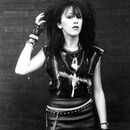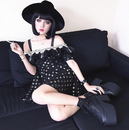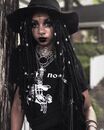NSFW Content Warning: This page does make a brief mention about "Fetish Goth", which combines the Goth aesthetic with BDSM themes.
This article discusses Goth music and the subculture surrounding it. For the art and literature that predated it, see Gothic. Goth is a subculture that was formed in the late 1970s-to-early 1980s in the UK. Gothic rock originally derived from the post-punk movement at the time, which included acts, such as Joy Division, the Siouxsie and the Banshees. Goth rock was predated by earlier bands being called "goth" (the first of which was The Doors, with their track "The End"). However, goth wouldn't be a defined genre until the release of Bauhaus' debut single "Bela Lugosi's Dead." Since the release of that track, many bands have formed to create and expand on the genre, intentionally or not (a lot of the original bands that are considered staples of goth rock actually hate the label, especially musicians such as Andrew Eldritch of Sisters of Mercy). Today, goth still thrives as an underground subculture with many organized events and festivals (most popular is the annual Wave-Gotik-Treffen, or WGT for short, which takes place in Leipzig, Germany).[1]
Music
While it's debated on what genres are classified as goth, there are five main genres that are agreed upon as being "goth." These include:
- Gothic rock (alternately called goth-rock) is the original genre that kicked off the goth subculture we know today. As mentioned above, the first goth-rock track is agreed upon to be "Bela Lugosi's Dead" by Bauhaus. This genre includes "scything" guitars, melodic basslines and minimal/sparse percussions. Second-wave goth rock is harder sounding, while still maintaining the definitive goth-rock sound (a famous example of second-wave goth-rock would be The Sisters of Mercy's "This Corrosion"). Goth rock bands include Bauhaus, Siouxsie and the Banshees, The Cure, Southern Death Cult, and The Sisters of Mercy. Example.
- Deathrock, the United States rendition of goth, specifically formed in the West Coast during the 80s. Deathrock was originally formed straight from the punk movement, and this can be heard in it's music. Deathrock music is the loudest and fastest of the official goth music, coupled with a fondness for dark lyrics and a fascination for cheesy monster movies and sci-fi. Deathrock would eventually merge with the UK goth scene, and therefore be closely connected to the goth scene from there. A few deathrock bands include Alien Sex Fiend, Christian Death, 45 Grave and Specimen. Example.
- Darkwave, a more synth heavy version of goth rock. Being inspired by the different "-wave" scenes at the time, darkwave combined the established genre of goth rock with more electronic instruments, such as synths and drum machines, although acoustics were still used alongside. What was then made was a combination of post-punk and new wave. Darkwave is still a very prominent part of the goth subculture, with many modern goth bands adapting the style of this particular genre, most notable being Lebanon Hanover and Linea Aspera. Example.
- Coldwave. Forming from the late-1970s French post-punk scene, coldwave takes darkwave and electrifies it even more. Like it's name would suggest, coldwave has a cold and minimal sound with it's music, making use of synths and other electronic machines much like other "-wave" genres. Although it didn't gain significance during its inception, coldwave would later go on to become more prominent on the scene during the late 1990s and early 2000s worldwide. An example of a coldwave band could be Molchat Doma. Example.
- Etherealwave aims to combine the electronics of darkwave with the moody atmosphere of regular goth rock and post-punk. Etherealwave has been described as dreamy and otherworldly by listeners of the genre. A reverbed and echo-y guitar is a staple of the genre, which is what creates the dreaminess of the etherealwave genre. Etherealwave also takes inspiration from other genres such as shoegaze and dreampop, with bands such as Cocteau Twins being listed as originators of these genres. Etherealwave bands include Lycia, Trance to the Sun and Autumn. For a related music genre, check out the Shoegaze page. Example.
For more information and examples, please refer to this video.
Some genres are less-prevalent, or goth-aligned. These genres include:
- Minimalwave is the most simplistic sounding of the goth genres. Minimalwave strips down the complexity of the other genres to create an almost artificial sound, hence the "minimal" part. A key aspect of minimalwave is the simplicity of the instrumentation, both electronically and acoustically. This genre could be described as avant-garde by most. Example.
- Post-punk is the genre which goth rock and its sub genres formed from. To note, all goth rock is post-punk, but not all post-punk is goth. Post-punk bands include Joy Division, Wire and Talking Heads. To get an extensive description of post-punk, refer to this page. Example of goth-aligned post-punk.
- Grey rock is what the Portuguese goth scene refers to post-punk and gothic rock as. As such, these bands are exclusively Portuguese only. More information can be found here.
Playlists
- Dark & Gothic Official Spotify Playlist
- Goth Essentials Spotify playlist by Derrick Johnson
- Goth/Darkwave Spotify playlist by Beach Fossils
- Gothic Rock Spotify playlist by Timothy Walschaerts
- The Numero Guide to Cold Wave & Minimal Synth by Numero Group
- The Sound of Ethereal Wave by The Sounds of Spotify
Beginner Albums to Goth
- In the Flat Field by Bauhaus
- First and Last and Always by The Sisters of Mercy
- Disintegration by The Cure
- Juju by Siouxsie and the Banshees
- Acid Bath by Alien Sex Fiend
- Ehtazi by Molchat Doma
Fashion
Gothic fashion is a clothing style marked by conspicuously dark, mysterious, antiquated, and homogeneous features. It is mostly worn by members of the Goth subculture. A dark, sometimes ghastly fashion and style of dress, typical gothic fashion includes an unhealthy complexion with dyed black hair, dark lipstick, and dark clothing. Both male and female goths can wear dark eyeliner and dark nail polish most especially black. Styles are often borrowed from punk fashion, Victorians, Edwardians, and Elizabethans.
Like punks, gothic fashion is mainly about DIY and thrifting clothes (its highly encouraged, even). Secondhand-black clothes, handmade jewelry, modifications on tights and jeans, and jackets with patches are some of the more common staples of DIY'd gothic fashion. Most expensive of the common accessories are the shoes (usually combat boots or winklepickers, the latter being a joke among goths that it is THE goth shoe). However, there do exist some goths who prefer to shop from the vendors below.
Fashion-Based Aesthetics
Since a big part of goth is the fashion, a lot of styles were influenced by the subculture's looks. As a result, a plethora of gothic fashion styles exist today. While there are a variety of individual styles to choose from, below are some of the more well-known looks.
Bubble Goth
Bubble Goth is aesthetically designed to combine more pop-ish elements with the Gothic aesthetic. This particular aesthetic is more so related to the pop and techno music scenes than it is actual goth.
For more information on this aesthetic, please check out our Bubble Goth page.
Cabaret Goth
Also known as Burlesque Goth, this is a type of goth that combines goth with Victorian (or at least, older age) fashions. It is possible that this particular goth fashion takes inspiration of the flapper-girl look, with their black hair and dark, lacy dresses.
Chained Goth
Chained Goth is a gothic-based aesthetic centered around chains. Wearing chains around a skirt, or chain bracelets, necklaces, and belts. The classic goth style, edgy and dark, with a few chains thrown in as an attempt to seem threatening, edgy, and tough.
Corporate Goth
Sometimes known as City Goth or shortened to Corp Goth, Corporate Goth is a subgenre of gothic fashion that blends it with Corporate fashion standards. It was first adopted as a response to dress codes in corporate settings, such as offices, this type of fashion is often worn in non-working situations by those with mature, smart, and gothic taste. Corp Goths wear formal black clothing, maroon or any other dark-shade, as well as a necklace or earrings if the setting allows for it.
Cybergoth
The Cybergoth aesthetic is a mixture of the Cyberpunk, Goth, and Raver aesthetics into one colorful and unique package. While cybergoths are not exactly connected to the overall goth subculture, some cybergoths do listen to goth-aligned genres, such as EBM, dark-electro and witch house.
For more information, please visit out Cybergoth page.
Casual Goth
Casual Goth is a type of goth that dresses on the more casual sides. Black jeans, shorts, boots and tees are the main clothing of choice. Casual goths may try to incorporate band merch and t-shirts into their wardrobe.
Darkwavers
A type of goth who listens to mainly darkwave (a subgenre of goth music that fused goth rock and synthpop/new wave). Some darkwave bands include Clan of Xymox, The Frozen Autumn, Corpus Delicti, Lycia and Lebanon Hanover. Some darkwavers dress in a more ethereal fashion style (longer hair, lacy fishnets, and flowing/sleeved clothing or dresses), but many others will dress similarly to trad goths.
For more information on a related aesthetic, please swing by the Synthwave page. :)
Deathrockers
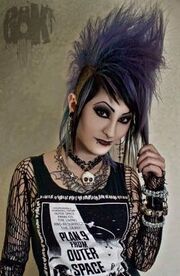
Deathrocker
The United States version of 80s goth. They are fans of deathrock music, as well as post-punk/punk. Some deathrock bands include Alien Sex Fiend, Christian Death, 45 Grave and Specimen. They dress in a much more punk-based fashion style but turned dark. Fashion staples include: shaved deathhawk hairstyle, ripped fishnets, ripped clothing, heavy dark makeup, and large boots.
For more information on this particular aesthetic, please check out the Deathrock page.
Fairy Goths
A mix between Romantic goths and Medieval goths. The aesthetic follows the themes of mystical and ethereal creatures (i.e. fairies and spirits of the forests). Fairy Goths may wear long, lacy dresses, fake elf ears and wings to look like a fae.
Fetish Goth
An aesthetic combining BDSM-themed clothing and goth fashion. This includes latex clothing, fishnets, collars and other BDSM-related gear. It should be noted that one does not have to be into BDSM or other fetishes to dress as this particular aesthetic.
Goshikku Gyaru
Goshikku is a Gothic take on the Gyaru fashion, combining elements of the Western Goth look with the Japanese Gyaru look.
For more information on this, we recommend checking out the Goshikku Gyaru page over on The Gyaru Wikia and tell them the Aesthetics Wiki says hi.
Gothic Lolita

Gothic Lolita
The Gothic Lolita look takes the popular Lolita look but gives it a Gothic spin. These include elegant dresses with laces, fancy collars, lacy-headbands, and fancy shoes. The Gothic Lolita look attempts to invoke a sense of elegance and nobility similar to Victorian Goths.
For more information on this, we recommend checking out the Gothic Lolita page over on the Lolita Fashion Wiki and tell them the Aesthetics Wiki says hi.
Health Goth
A slightly-contested variation of Goth, Health Goth is split into two camps: one which is Goth mixed with elements of Cleancore and Medicalcore to produce a uniquely sterile aesthetic, while the other is Goth with more of a nod towards pursuing physical fitness and being in shape, while still maintaining the goth aesthetic.
For more information on these two aesthetics, please visit our Health Goth page.
Hippie Goths
A mix of Hippie and Goth fashion. It involves nature-loving, following Paganism and/or Wicca and/or misc. It also includes candles, crystals, incense, Tarot and other Wiccan items.
Medieval Goth
An aesthetic that's a mix of medieval times and gothic fashion. It involves history, museums, castles, churches and ancient monuments.
Midwest Gothic
Midwest Gothic is primarily a literary tradition, combining the tone of gothic literature with the setting of the American Midwest.
For more information, please check out our Midwest Gothic page.
Nu-Goth
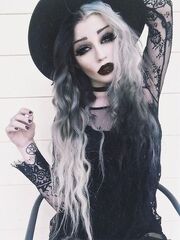
Nu-Goth
Nu-Goth is a modern take on a goth subculture that is heavily rooted and influenced by traditional gothic music, aesthetics and philosophy.
For more information, please check out our Nu-Goth page.
Pastel Goth
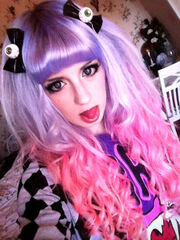
Pastel Goth
Much like with Bubble Goth, Pastel Goth takes more the cutesy and kid-friendly pastel colors often seen and blends it in with the harsh blacks often associated with Goth culture, creating a very interesting and unique look. It is not uncommon to see the colors pink and purple mixed with black with this particular aesthetic. Like Bubble Goth too, it's also not particularly common to see this style in the actual goth scene.
For more information, please visit our Pastel Goth page.
Romantic Goth
The Romantic Goth is a combination of the Goth look with elements from the Romantic period that makes up the first half of the 19th century.
For more information, please visit our Romantic Goth page.
Southern Gothic
Much like Midwestern Gothic, Southern Gothic takes elements of Gothic literature and combines them instead with elements of the American South, often done as a critique on what is often viewed as the backward traditions of the American South.
For more information, please check out our Southern Gothic page.
Trad Goths
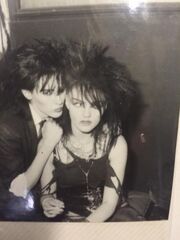
Trad Goth
The original UK 80s goths. They are fans of post-punk/goth rock music, such as Bauhaus, Siouxsie and the Banshees, The Cure, Southern Death Cult, and The Sisters of Mercy. They dress in traditional goth fashion that is inspired by punk and 1980s fashion but with darker tones. Fashion staples include large/teased hair, layered clothing, fishnets, winklepicker shoes/boots, and heavy dark makeup.
For more information, please visit our Trad Goth page.
Tribal Goths
Tribal Goth is a subgenre that uses traits like belly dancing garb, hipskirts and jewelry, bones and wood accessories with the goth scene, trying to mix the tribal look in with the goth look.
It should be noted that non-indigenous people should not try this style, as it takes inspiration from indigenous cultures, and therefore should be treated respectfully as such.
Victorian Goth
A sub-genre of goth that combines Victorian and Goth. The subgenre involves poetry, tea, plays, formal parties, opera, and classical music in general. This aesthetic is based on imitating the lifestyle of the Victorian era, especially the aristocrats since these were the ones who wore these extravagant clothes.
For more information on this aesthetic, please check out the Victorian Goth page.
Woodland Goth
Woodland Goth, also known as Dark Fairycore, blends elements of goth culture with elements of nature and woodland survival (something akin to the Brothers Grimm fairy tales).
For more information on this aesthetic, please check out the Woodland Goth page.
Misconceptions About Goth
With a lot of alternative scenes, comes a lot of reconvinced notions and assumptions. Goth is no exception to this. This section aims to clear these misconceptions up for an overall better understanding of what goth is about.
- Goth is for everyone, regardless of race, gender, sexuality, religion and so on.
- While fashion is an important aspect of the goth subculture, most goths believe that it should be the music you prioritize first.
- On the topic of music, many genres and subcultures are mistaken for goth. These genres are, but not limited to, Nu-metal (Korn, Slipknot), Emo (My Chemical Romance), Industrial (Nine Inch Nails, Skinny Puppy), Dark pop (Billie Ellish), Emo trap/Emo rap (XXXTentacion, Lil Peep, GothBoiClique, etc.), Grunge (Nirvana), Symphonic metal (Evanescence), and Gothic metal (Type O Negative). You can still like these genres alongside goth rock and its subgenres.
- Also, you do not have to listen to goth 24/7 to be goth. Just as long as you like goth music, you're goth.
- Goth is also not a mindset. If you like dark and spooky things, you instead fall into the category of darkly-inclined (which goths can be alongside).
- Similarly, being into monster stories and other dark media does not automatically make you goth. Being into gothic architecture, settings, or designs doesn't make you automatically goth either. This is instead called gothic. It is, however, referenced a lot in the music, so being into Dracula or The Invisible Man might expand your knowledge on the lyrical content.
- Dark, black clothes or alternative fashion ≠ Goth.
- Being sad or depressed ≠ Goth (and by extension, Emo).
Resources
Blogs
Vendors
- BlackCraft Cult
- Disturbia
- Empty Society
- Goth Mall
- Lip Service
- Mysticum Luna
- New Rock
- Punk Rave
- Stay Cold Apparel
- Synthicide
- Underground


